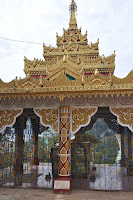We stopped right in front of the Mount Popa which technically is a spur of the Bago Yoma range, an extinct volcano we would soon be visiting. It was quite a sight and I believe a preparation for the forthcoming climb to the temple on its summit, which would definitely be hard by the look of it and the warmth one was beginning to feel.
Situated about half way up the mountain stands the Mahagiri Nat Temple where we stopped first. The veneration of spirit heroes known as Nat is known to be peculiar to Myanmar once it runs in parallel with the rituals of Theravada Buddhism. Noticing the importance Burmese worshippers attributed to those King Anawrahta chose to incorporate Nat in the local Buddhist mythology (albeit in an inferior position to the Buddha).
It was he who first fixed the Nat pantheon in the 11th century, incorporating 37 of the most popular Nat spirits, all of whom have their own peculiar origin myth. They are all said to have had violent deaths with the exception of Thagyamin, the king of the Nats.
Chocho tried to tell us some of the legends around the various characters, as we wandered about on the gallery. According to history there are nevertheless Nats which have becoem closely associated with Mount Popa - May Wunna, being one of them.
It was he who first fixed the Nat pantheon in the 11th century, incorporating 37 of the most popular Nat spirits, all of whom have their own peculiar origin myth. They are all said to have had violent deaths with the exception of Thagyamin, the king of the Nats.
Chocho tried to tell us some of the legends around the various characters, as we wandered about on the gallery. According to history there are nevertheless Nats which have becoem closely associated with Mount Popa - May Wunna, being one of them.
May Wunna, a flower-eating ogress who is said to have ruled over the mountain fell in love with a certain Indian Muslim at the service of the King, who had him executed for neglecting his duties, after which May Wunna is said to have died of a broken heart. Their two sons, Min Gyi and Myin Lay were also later executed. The Nat pwe (annual festivities where special oracles dominate the proceedings) festival is celebrated in their honour.
We could see that worshippers had left quite an amount of money they had put either inside special containers placed in front of some of the statues representing the Deities, or even inbetween their fingers.
Popular faith and local beliefs have always played an important role in the religious approach some people have, regardless of the "official" religion and although there's no exact parallel as to what goes on in Portugal some worshipping practices related to legendary or pagan figures are still carried out with the same fervent belief, I was therefore not shocked by the Nat worshipping but thoroughly interested in it.































No comments:
Post a Comment